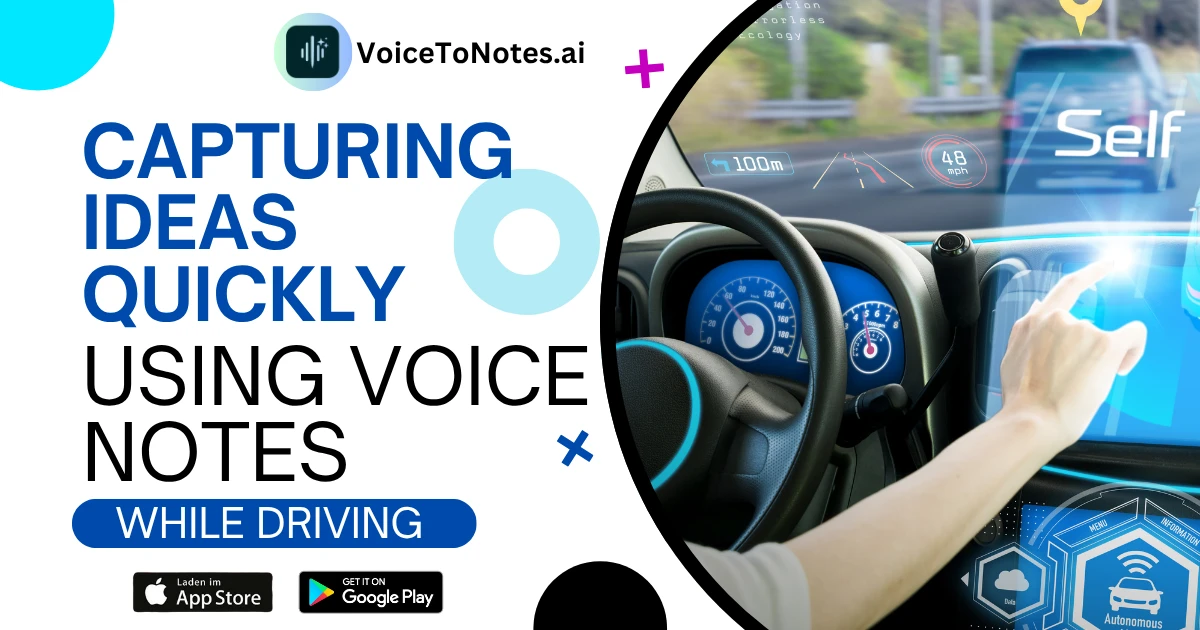
Thousands of people have flashes of thought or momentary reminders daily when driving. But safely jotting the ideas down?
That is the problem.
With hands full and eyes on the road, typing or writing is not an option, and risking a distraction isn't worth the risk.
The smart answer? Hands‑free voice note app — instant, reliable, and built for on-the-go idea capture. Using voice-to-notes for fast idea capture has become a practical solution for people who want to stay productive even while on the move.
This tutorial will show you exactly how to make the most of your ideas and capture them to safely and efficiently record your thoughts on the go.
We'll cover how to set up your device, avoid common pitfalls, keep your privacy intact, and organize your notes later to maximize your return on time.
Why Voice Notes are the Best Choice for Capturing Ideas Behind the Wheel
Voice notes are the fastest and best way of jotting down your ideas when you are in transit.
Speaking is much faster than typing or writing since the rate of speaking is more than 150 words per minute, while typing on a phone keypad is about 40 words per minute.
The speed factor enables you to record complicated ideas in real time without the frustration of leaving out critical details.
Additionally, since these include less like texting or typing, they minimize manual distraction so you may have your eyes on the road and hands on the wheel.
This is important because while hands-free technology avoids physical distraction, cognitive distraction—where your mind is engaged in something else besides driving—may still occur.
Effective use would have you limiting your dictations to something short and straightforward and dictating only when it's safe to do so on the road.
It’s also worth mentioning that the majority of drivers are completely unaware of the amount of risk that comes with even hands-free use.
Phone talk or dictation of notes has already been found to distract mental attention, so awareness and caution are paramount.
Avoid dictating during bad weather, confusing intersections, or heavy traffic to enable maximum safety.
Setting Yourself Up for Success: How to Use Voice Notes Safely and Effectively
Before you make use of voice to text while driving, you should properly configure your device to enable it for hands-free operation. This process is usually overlooked by most users, but an easy setup can make all the difference when it comes to safety and recording quality.
Second, activate your phone's voice assistant — whatever that may be, Siri, Google Assistant, Bixby, or whatever.
That lets you initiate recording without needing to touch your phone, with simple wake phrases like "Hey Siri" or "Ok Google."
Most modern cars also support Apple CarPlay or Android Auto, which embeds your voice assistant directly in your car's infotainment system for even more convenient use.
Choosing the right app is crucial, too.
While Otter.ai, Notta, and VoiceToNotes.ai are popular apps with transcription features, some lack strong privacy measures or have patchy transcription accuracy, annoying users who require accurate note-taking.
Look for apps with serious data security in place — for example, apps that encrypt voice data in transit and storage — and transcription personalization options that can accommodate your accent and language requirements.
Also, search for apps that allow you to tag or label notes in real time, allowing you to begin categorizing ideas once you finish your drive.
This prevents a backlog of unprocessed recordings, which otherwise results in confusion and decreased productivity.
Have your device handy, and attempt to issue short commands and take short notes.
This reduces mental effort and transcription errors, and your notes will be simpler to review later on.
The Growing Importance of Privacy and Data Protection in Voice Notes
As adoption of voice technology grows stronger, privacy is a major issue for many users today.
Transcription apps, unlike ordinary audio recordings, will typically upload your voice files to the cloud for processing.
If not properly secured, this type of data is vulnerable to data breaches or misuse.
Most users have deserted universal apps that put quantity above security and demand apps with user privacy as default.
When selecting your app, look for transparent privacy policies, strong encryption mechanisms, and the option to locally store data in the event you do not need to use cloud storage.
Other features like two-factor authentication of your account add an extra layer of protection.
In certain careers—e.g., medicine, law, or finance—where confidential information is being shared, it is a matter of law that absolute confidentiality must be maintained.
Such professionals must necessarily choose a voice notes solution that is compliant with data protection legislations such as HIPAA or GDPR.
Protecting your ideas doesn't just keep confidential business ideas or personal reminders from getting misused; it also builds trust, so you can feel free to include them as a standard part of your work routine.
Practical Tips on How to Record and Organize Voice Notes Effectively
Voice note-taking is only the first step; turning them into actionable information completes the efficiency loop.
High performers endorse the following approaches:
Use transcription services: Many apps transcribe your voice memos automatically into searchable text.
This way, you can quickly locate specific ideas later without having to listen to entire recordings.
Tag and categorize notes: Immediately after your trip, categorize your transcriptions into projects or categories.
This simple step prevents ideas from piling up and being lost.
Integrate with productivity apps: Link your voice and ideas to apps like Evernote, Voicetonotes.ai or Trello and have a look at this detailed guide on How Voicetonotes Boosts Productivity to make your workflow more efficient by turning ideas into tasks or events on your calendar.
Review and revise immediately: Never let notes pile up. Reviewing them carefully after recording keeps things in context and makes you more likely to act on your ideas.
Remember in your notes: Some apps allow you to turn your voice notes into to-do lists or calendar reminders so you'll never forget to follow up.
Real-Life Examples: How Voice Notes Keep People Productive on the Go
A campaign strategist dictates campaign ideas on their daily commute, later transcribing using transcription software to organize and fill in the details.
- A writer captures some lines of dialogue or plot developments when traveling between meetings so ideas don’t slip away.
- A sales executive captures customer information and follow-up steps by voice notes immediately upon completion of the calls, improving efficiency and accuracy.
- A student dictates study reminders or lecture notes while on the move or traveling, maximizing study time.
These everyday instances bear witness to the power of idea capture on the go — showing how your voice can become your most productive tool, no matter your lifestyle or profession.
Frequently Asked Questions
The majority of users inquire whether or not it is safe, legal, and effective to listen to voice notes while driving. Below are answers integrated into the flow:
Is voice-to-text safe to use while driving?
Yes, especially for hands-free and brief dictations. It is much safer than texting or typing while you're driving.
Is voice command use distracting?
Physical distraction is avoided but mental distraction can be had. Use voice notes cautiously and sparingly, especially in heavy traffic.
Are voice messages sent while driving?
Hands-free systems typically enable voice messaging to be sent, but always observe local regulations and reduce distractions.
How can I safely dictate notes?
Pre-program your device, use simple commands, and don't dictate long or complex messages when you are behind the wheel.
Conclusion
The Clear Solution to Capture Ideas Safely on the Go. Voice notes are the perfect mix of convenience, speed, and safety — designed for busy professionals and artists who don't want to lose a single idea.
With proper setup of your device, choosing apps based on privacy and accuracy, and by developing dictation safety practices, you can turn your daily commute into a productive one.
Ready to capture your thoughts with ease and protection?
Meet VoiceToNotes.ai — a new, privacy-focused transcription app built to allow you to capture all your ideas on the move with precision and confidence.
